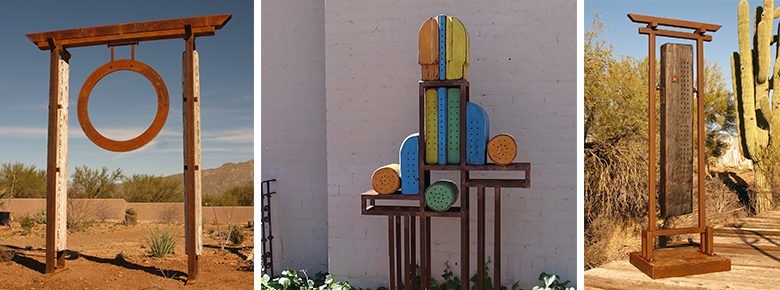Award: Research & Development Grant
Discipline: Visual Arts
Project Collaborator(s):
City/Town: Tucson
Year: 2019
Artist Website: www.cormanart.com
Few people consider sculpture as a habitat feature, so demonstrating the ideas and techniques behind them opens new possibilities for creating more ecologically friendly spaces.
Excerpt from Greg Corman’s R&D Grant application
Habitat loss from development and urban gardening practices has had a significant impact on native wildlife, but creation of habitat features in landscapes can help mitigate the damage. In consultation with wildlife and materials experts, sculptor and landscape designer Greg Corman will build experimental habitat sculptures that benefit several species, be they birds, mammals, insects or reptiles.
Corman has been creating native-bee nest sculptures for 10 years. His work can be seen at Tohono Chul Park, the AZ-Sonora Desert Museum, Phoenix Zoo, Boyce Thompson Southwest Arboretum, Tucson Botanical Gardens, Albuquerque Zoo, and in other public gardens. In addition to bee habitats, he’s made raptor perches, “lizard lairs”, and squirrel “jungle gyms” for his own use and sees a broader market for wildlife habitat sculptures—works that are aesthetically pleasing for humans while enhancing the quality of life for wild creatures.
The research and experimentation supported by his R&D Grant will expand Corman’s own expertise, but he hopes to achieve a greater impact by encouraging wildlife organizations, landscape designers, teachers, and others to create their own habitats, whether sculptural or not. To this end, he has plans to exhibit his sculptures in Tucson and demonstrate his materials and techniques. He will also provide online resources for more distant audiences.
Work Samples

Untitled bee habitat. 2017. Private residence, Tucson, AZ. 6′ x 2′ x 2′

Untitled bee habitat. 2016. Commissioned piece for a private
residence. Tucson, AZ. 8′ x 5′ x 2′

Untitled bee habitats. 2015. Sent to clients in Minnesota. 24″ x 6″ x 3″
 Greg Corman divides his time between two passions, sculpture and landscape design. His art work reincarnates discarded steel and wood to create objects in both the decorative and functional realms. He works to maintain as much patina and history as possible, for the “stories” evoked by the materials, either real or as products of the viewers’ imaginations, can add great appeal to a sculpture. His approach is mostly intuitive and exploratory, building from existing materials in a process that is sometimes gratifying, sometimes frustrating, but results in one-off abstract pieces reflecting a range of emotions. The compositions are often influenced by plant life and natural elements of the desert which are constants in his other work as a botanist and landscape designer.
Greg Corman divides his time between two passions, sculpture and landscape design. His art work reincarnates discarded steel and wood to create objects in both the decorative and functional realms. He works to maintain as much patina and history as possible, for the “stories” evoked by the materials, either real or as products of the viewers’ imaginations, can add great appeal to a sculpture. His approach is mostly intuitive and exploratory, building from existing materials in a process that is sometimes gratifying, sometimes frustrating, but results in one-off abstract pieces reflecting a range of emotions. The compositions are often influenced by plant life and natural elements of the desert which are constants in his other work as a botanist and landscape designer.
Greg’s horticultural and design experience spans nearly three decades in the desert regions of Australia, Saudi Arabia, and Arizona. He is the owner of Gardening Insights, Inc., an award winning landscape design and consulting firm in Tucson which specializes in ecological gardens and wildlife habitat landscapes.
It’s the nexus of these passions that he finds most interesting and his sculptures that incorporate native bee nesting habitats can be found in the Arizona-Sonora Desert Museum, the Phoenix Zoo, Boyce Thompson Arboretum, Tohono Chul, the Tucson Botanical Gardens and other public spaces.






